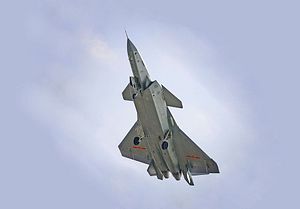Last week, the South China Morning Post reported that the Chinese People’s Liberation Army Navy (PLAN) has decided to pursue converting the J-20 stealth fighter into its primary carrier-borne combat aircraft. Reportedly this decision stems from concerns about the development of the FC-31, and worries that an economic downturn will starve the service of resources.
The J-20 would be big for a carrier-based fighter, but certainly not the largest that has ever flown. The Grumman F-14 had a slightly higher take-off weight, although it was a bit shorter. The A-5 Vigilante, which operated from U.S. carriers in the 1960s, was slightly longer but somewhat lighter. The J-15, which China’s two existing carriers operate, is slightly longer but also lighter.
The timeline for developing a carrier variant of the J-20 remains unclear. Converting the aircraft to naval service may take some time. The idea of taking a primarily land-based fighter and modifying it for flight decks is not unheard of; the J-15 is an obvious example of a relatively successful conversion, as is the MiG-29. The United States toyed with the idea of developing a carrier variant of the F-15 before settling on the F-14 and eventually the F/A-18. Indeed, the Hornet grew out of the YF-17 Lightweight Fighter Project, which competed directly with the F-16 to provide an affordable aircraft to the U.S. Air Force.
Operating from a carrier would certainly enable the J-20 to better perform what many analysts envision to be its two primary missions, long-range strike and long-range air superiority. Using the PL-15 BVRAAM, a carrier battle group with J-20s could push U.S. tanker and early warning aircraft deep into the Pacific, as well as threaten installations such as Guam. Of course, any PLAN carrier leaving the friendly confines of the first island chain would become extraordinarily vulnerable to attacks from U.S. submarines and aircraft.
It does not seem likely that the PLAN will operate the J-20 from either of its existing carriers, as the design and weight would strain deck and launch capacity. But perhaps we can expect the J-20 to grace the decks of the next Chinese carrier. Carrier 003, equipped with electromagnetic catapults, could probably operate the J-20. It remains to be seen whether China will continue development on a smaller, complimentary stealth fighter that could fly from the older two carriers. If not, there will be an even more distinct difference between the two generations of Chinese aircraft carriers, as the latter will be stuck with the non-stealthy J-15 for the foreseeable future.

































